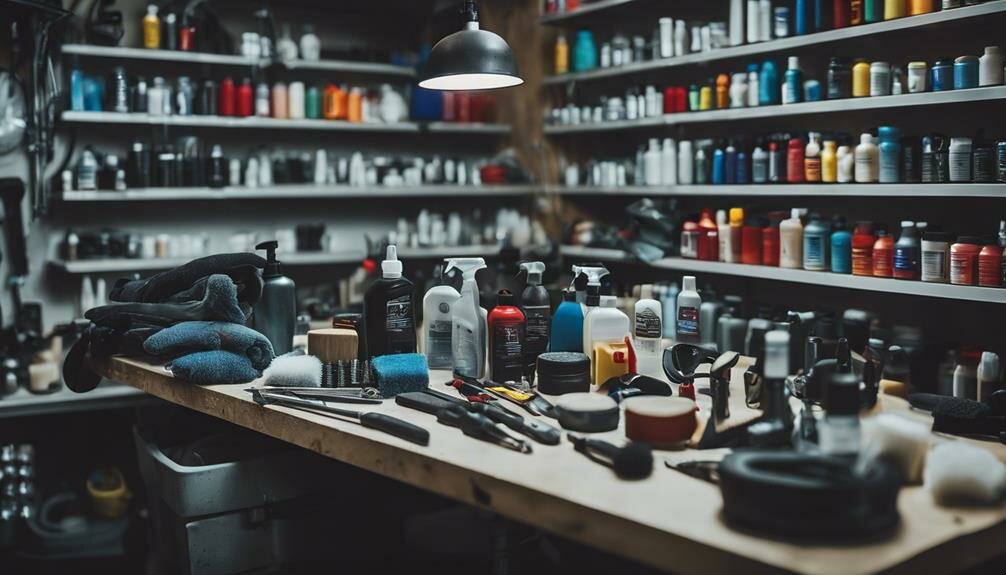Auto Detailing Tools and Equipment
To achieve professional auto detailing results, you need the right tools.
Pressure Washers
- Nozzles: 0-degree to 40-degree for various tasks.
- Pressure Ranges: 1,300-1,800 PSI for light cleaning, over 2,600 PSI for heavy-duty.
Polishing Machines
- Rotary Polishers: Effective for heavy correction.
- Dual Action Polishers: Beginner-friendly, essential.
- Random Orbital Polishers: Best for moderate correction.
Interior Cleaning Tools
- Versatile handheld nozzles, crevice tools, dusting brushes, and extension wands.
Ceramic Coatings
- Preparation: Clean surface is vital.
- Application: Work in small sections.
Continue discovering the details to elevate your auto detailing skills.
Pressure Washers

Investing in a quality pressure washer can greatly enhance your auto detailing efficiency and results. With a powerful pressure washer, you can remove dirt, grime, and debris from your vehicle's exterior quickly and effectively. Understanding the different nozzle types and water pressure settings is essential to achieving the best results and protecting your vehicle's surface.
Nozzle Types
- 0-Degree Nozzle: This nozzle provides a concentrated stream of water, ideal for tough stains. However, it can be too harsh for delicate surfaces.
- 15-Degree Nozzle: This nozzle delivers a narrow, high-pressure spray, making it suitable for removing stubborn dirt and grime.
- 25-Degree Nozzle: This nozzle offers a wider spray pattern, balancing cleaning power and surface protection, perfect for general use.
- 40-Degree Nozzle: This nozzle provides a broad spray, making it the safest option for sensitive surfaces like car paint.
Water Pressure
- Low Pressure (1,300-1,800 PSI): Suitable for light cleaning tasks and delicate surfaces.
- Medium Pressure (1,800-2,600 PSI): Ideal for most auto detailing tasks, offering a balance between power and safety.
- High Pressure (2,600 PSI and above): Best for heavy-duty cleaning but can be too aggressive for some vehicle surfaces.
Polishing Machines
When it comes to polishing machines, you'll find a variety of types, each suited for different tasks. Understanding how to use these machines effectively can make a significant difference in the quality of your work. Let's explore the different machines available and the best techniques to use them.
Types of Machines
Types of Machines: Polishing Machines
Polishing machines are essential tools for achieving a flawless finish on your vehicle's exterior. These machines help you remove imperfections, such as scratches and swirl marks, while enhancing the paint's shine. Let's explore the different types of polishing machines you might use.
Rotary Polishers
- Description: Rotary polishers have a single, circular motion.
- Use: Ideal for heavy correction and removing deep scratches.
- Pros: Highly effective for significant paint correction.
- Cons: Can generate excessive heat, potentially damaging paint if misused.
Dual Action (DA) Polishers
- Description: DA polishers combine rotary and oscillating motions.
- Use: Suitable for both beginners and professionals.
- Pros: Safer than rotary polishers, reducing the risk of paint damage.
- Cons: May take longer to correct severe paint issues.
Random Orbital Polishers
- Description: These polishers move in a random pattern.
- Use: Best for light to moderate paint correction.
- Pros: User-friendly and safe for novices.
- Cons: Less effective for deep scratches and heavy correction.
Complementing these machines with tools like steam cleaners and foam cannons can greatly enhance your detailing results. Steam cleaners help sanitize and clean hard-to-reach areas, while foam cannons ensure thorough pre-washing, reducing the risk of scratching during the polishing process.
Understanding the types of polishing machines available allows you to choose the right tool for your specific needs.
Usage Techniques
Usage Techniques (Polishing Machines)
Mastering the proper usage techniques for polishing machines guarantees you achieve the best possible results while safeguarding your vehicle's paintwork. Start by confirming the surface is clean and free of contaminants. Use a clay bar to remove embedded particles, enhancing the smoothness and readiness of the paintwork.
Preparing the Surface
- Clean Thoroughly: Wash the car using a high-quality car shampoo.
- Clay Bar: Glide the clay bar over the wet surface to remove contaminants.
- Drying Method: Use a microfiber towel to dry the car completely, making sure no water spots remain.
Polishing Techniques
- Choose the Right Pad and Polish: Select a polishing pad and compound suitable for your vehicle's paint type.
- Apply Polish: Dab small amounts of polish onto the pad.
- Set Speed: Set your polishing machine to a low speed for spreading the polish, then increase the speed for actual polishing.
- Polish in Sections: Work in small sections, moving the machine in overlapping, horizontal and vertical passes.
- Wipe Off Residue: Use a clean microfiber cloth to remove any remaining polish residue.
Post-Polishing
- Inspect: Examine the polished area for any missed spots.
- Reapply if Needed: Repeat the process if more polishing is required.
- Final Drying: Make sure the vehicle is completely dry before waxing or sealing.
Interior Cleaning Tools

When addressing your car's interior, you'll need the right tools to guarantee a thorough clean. Essential vacuum attachments help you reach tight spaces and corners, while upholstery cleaning solutions target and remove stubborn stains. Together, these tools make it easier to maintain a spotless and fresh interior.
Essential Vacuum Attachments
To achieve a spotless car interior, you'll need a range of essential vacuum attachments designed for various cleaning tasks. These attachments help you reach tight spaces, collect stubborn dirt, and maintain overall cleanliness.
Handheld Nozzles
Handheld nozzles are versatile and allow for efficient cleaning of larger surfaces like seats and floor mats. They come in various sizes and shapes to suit different areas of your vehicle. Opt for a nozzle with a brush attachment to help lift dirt from fabric surfaces more effectively.
Crevice Tools
Crevice tools are indispensable for reaching those narrow gaps between seats and around the console. Their slim design allows them to get into places where larger nozzles can't fit. Use these tools to remove crumbs, dirt, and debris that accumulate in hard-to-reach areas.
Additional Attachments
- Dusting Brushes: Ideal for cleaning dashboards, vents, and other delicate surfaces. Their soft bristles prevent scratches while effectively collecting dust.
- Extension Wands: These help you clean under seats and other difficult-to-access areas without straining yourself.
Upholstery Cleaning Solutions
Upholstery Cleaning Solutions
Maintaining clean upholstery requires specialized cleaning solutions that can tackle stains and refresh the fabric without causing damage. You need products specifically designed for automotive interiors, as household cleaners may be too important or ineffective.
Stain Removal
For effective stain removal, choose an upholstery cleaner that targets specific types of stains, such as oil, food, or ink. Apply the cleaner directly to the stained area, then use a soft-bristle brush to gently work the solution into the fabric. This method helps lift the stain without damaging the upholstery.
Fabric Protection
After cleaning, it's significant to apply a fabric protection spray. This product creates a barrier on the fabric, repelling future stains and making future cleaning easier. Simply spray the protector evenly over the upholstery and allow it to dry completely.
Tips for Best Results
- Test First: Always test any cleaning solution on a small, inconspicuous area to ensure it doesn't damage or discolor the fabric.
- Follow Instructions: Adhere strictly to the product's instructions for best results.
- Regular Maintenance: Clean and protect your upholstery regularly to keep it looking new and extend its lifespan.
Microfiber Towels
Microfiber Towels
Microfiber towels are essential in auto detailing due to their superior absorbency and ability to trap dirt without scratching surfaces. These towels are perfect for drying techniques because they can absorb several times their weight in water, ensuring that your vehicle dries quickly and thoroughly.
Drying Techniques
When using microfiber towels for drying, make sure to follow these steps:
- Blotting: Gently blot the wet surface to soak up excess water.
- Wiping: Use a sweeping motion to remove remaining moisture, ensuring an even coverage.
- Fold and Flip: Fold the towel into sections and flip it frequently to utilize dry areas.
Towel Maintenance
Proper towel maintenance is essential to extend the life of your microfiber towels and maintain their effectiveness. Here's how to keep them in top shape:
- Wash Separately: Always wash microfiber towels separately from other laundry to avoid lint contamination.
- Use Mild Detergent: Opt for a mild, liquid detergent without fabric softeners or bleach, as these can degrade the fibers.
- Avoid High Heat: Dry the towels on a low heat setting or air dry to prevent damage.
- Store Properly: Keep your clean microfiber towels in a dry, dust-free environment.
Ceramic Coatings

After confirming your vehicle's surfaces are free of dirt and moisture with microfiber towels, you might want to consider applying ceramic coatings for enhanced protection and shine. Ceramic coatings create a durable layer that safeguards your car's paint from environmental contaminants, UV rays, and minor scratches.
Application Methods
To apply ceramic coatings, follow these steps:
- Preparation: Make sure the surface is thoroughly clean and free of any contaminants.
- Application: Use an applicator pad to apply the coating in small sections. Work in a cross-hatch pattern for even coverage.
- Buffing: After a few minutes, use a microfiber towel to buff the surface, removing any excess product.
Curing Time
Curing time is important for the effectiveness of ceramic coatings. Typically, the coating needs at least 24 hours to cure. During this period, keep the car in a dry, dust-free environment. Some advanced coatings may require up to 48 hours for full curing. Avoid washing or exposing the vehicle to extreme conditions during this time.
Detailing Brushes
When it comes to achieving those hard-to-reach areas, detailing brushes are indispensable tools in your auto detailing arsenal. These brushes help you clean intricate parts of your vehicle, ensuring a thorough and professional finish.
Brush Materials
Detailing brushes come in various materials, each suited for different tasks. Common materials include:
- Natural Hair: Soft and gentle, ideal for delicate surfaces like leather and polished metal.
- Synthetic Fibers: Durable and resistant to chemicals, perfect for heavy-duty cleaning.
Bristle Types
Different bristle types serve various cleaning needs. Understanding them helps you choose the right brush for the job:
- Soft Bristles: Great for dusting dashboards and vents without scratching.
- Medium Bristles: Suitable for general cleaning, offering a balance between softness and scrubbing power.
- Stiff Bristles: Best for tough grime on tires and engine bays.
Practical Tips
- Match Brush to Task: Always use the appropriate brush material and bristle type for the surface you're cleaning.
- Maintain Your Brushes: Rinse thoroughly after use to extend their lifespan and effectiveness.





